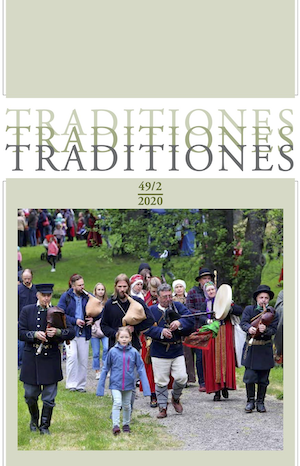Brazilska glasba med nacionalnim in regionalnim
DOI:
https://doi.org/10.3986/Traditio2020490205Ključne besede:
Brazilija, glasba, identitete, kulturni nacionalizem, Nordeste, severovzhodna Brazilija, sambaPovzetek
Po osamosvojitvi Brazilije leta 1822 so se intelektualci in politiki spoprijeli z vprašanjem, kako ustvariti skupno identiteto, ki bi v celoto povezala razsežno ozemlje in tam živeče skupnosti. V procesu oblikovanja nacionalne identitete so nastajale tudi regionalne, ki jih je zaznamovala želja po ohranjanju lastnega kulturnega izraza znotraj večje države. Pod vplivom množičnih medijev in elit, ki so delovale kot vratarji in hkrati razsodniki, so ljudski glasbeni izrazi prispevali k nastanku »brazilske« popularne glasbe.
Prenosi
Literatura
Albuquerque Jr., Durval Muniz de, and Laurence Hallewell. 2004. Weaving Tradition: The Invention of the Brazilian Northeast. Latin American Perspectives 31 (2): 42–61.
Anderson, Benedict. 2006. Imagined Communities: Reflections on the Origin and Spread of Nationalism. London, New York: Verso.
Bollig, Ben. 2002. White Rapper / Black Beats: Discovering a Race Problem in the Music of Gabriel o Pensador. Latin American Music Review / Revista de Música Latinoamericana 23 (2): 159–178.
Borges, Dain. 1995. The Recognition of Afro-Brazilian Symbols and Ideas, 1890–1940. Luso-Brazilian Review 32 (2): 59–78.
Celarent, Barbara. 2012. Rebellion in the Backlands by Euclides da Cunha. American Journal of Sociology 118 (2): 536–542.
Chandler, Billy Jaynes. 2000. Bandit King: Lampião of Brazil. College Station: Texas A&M University Press.
Chasteen, John Charles. 1996. The Prehistory of Samba: Carnival Dancing in Rio de Janeiro, 1840–1917. Journal of Latin American Studies 28 (1): 29–47.
Crook, Larry. 2009. Focus: Music of Northeast Brazil. New York & Oxon: Routledge.
Dunn, Christopher. 2001. Brutality Garden: Tropicália and the Emergence of a Brazilian Counterculture. Chapel Hill: University of North Carolina Press.
Enciclopédia Itaú Cultural de Arte e Cultura Brasileiras. 2017. Pelo Telefone (1916). http://enciclopedia.itaucultural.org.br/obra7091/pelo-telefone-1916.
Fry, Peter. 2000. Politics, Nationality, and the Meanings of “Race” in Brazil. Daedalus 129 (2): 83–118.
Fryer, Peter. 2000. Rhythms of Resistance: African Musical Heritage in Brazil. Michigan: Pluto Press.
Garcia, Thomas G. 1997. The “Choro,” the Guitar and Villa-Lobos. Luso-Brazilian Review 34 (1): 57–66.
Greenfield, Gerald. 2009. Lampião, Luiz and Padim Ciço: Three Icons of the Brazilian Northeast. Memory Studies 2 (3): 393–410.
Hess, Carol A. 2013. Representing the Good Neighbor: Music, Difference, and the Pan American Dream. Oxford: Oxford University Press.
Hobsbawm, Eric. 2000 (1983). Introduction: Inventing Traditions. In: Eric Hobsbawm and Terence Ranger (eds.), The Invention of Tradition. Cambridge: Cambridge University Press.
Jezernik, Božidar. 2004. Wild Europe: The Balkans in the Gaze of Western Travellers. London: Bosnian Institute.
Marx, Anthony W. 1996. Race-Making and the Nation-State. World Politics 48 (2): 180–208.
McCann, Bryan. 2004. Hello, Hello Brazil: Popular Music in the Making of Modern Brazil. Durham: Duke University Press.
Menezes Bastos, Rafael José de. 1999. The “Origin of Samba” as the Invention of Brazil (Why Do Songs Have Music?). British Journal of Ethnomusicology 8: 67–96.
Moric, Anja. 2020. Gottscheer Folk Song – From a Means of Fostering National Differentiation to a Memory Keeper in the Diaspora. Traditiones 49 (2): 141–166. DOI: https://doi.org/Traditio2020490208.
Murphy, John P. 2006. Music in Brazil. New York & Oxford: Oxford University Press.
Oliven, Ruben George. 1984. The Production and Consumption of Culture in Brazil. Latin American Perspectives 11 (1): 103–115.
Reily, Suzel Ana. 1992. Música Sertaneja and Migrant Identity: The Stylistic Development of a Brazilian Genre. Popular Music 11 (3): 337–358.
Reily, Suzel Ana. 2000. Introduction: Brazilian Musics, Brazilian Identities. British Journal of Ethnomusicology 9 (1): 1–10.
Roberts, Shari. 1993. “The Lady in the Tutti-Frutti Hat”: Carmen Miranda, a Spectacle of Ethnicity. Cinema Journal 32 (3): 3–23.
Santos, Sales Augusto dos. 2002. Historical Roots of the “Whitening” of Brazil. Latin American Perspectives 29 (1): 61–82.
Shaw, Lisa. 2002. Samba and Brasilidade: Notions of National Identity in the Lyrics of Noel Rosa (1910–1937). Lusotopie 2: 81–96.
Sheriff, Robin E. 1999. The Theft of Carnaval: National Spectacle and Racial Politics in Rio de Janeiro. Cultural Anthropology 14 (1): 3–28.
Vassberg, David E. 1976. African Influences on the Music of Brazil. Luso-Brazilian Review 13 (1): 35–54.
Veloso, Caetano. 2002. Tropical Truth: A Story of Music & Revolution in Brazil. New York: Da Capo Press.
Vianna, Hermano. 1999. The Mystery of Samba: Popular Music and National Identity in Brazil. Chapel Hill: The University of North Carolina Press.
Waddey, Ralph C. 1980. “Viola de Samba” and “Samba de Viola” in the Recôncavo of Bahia (Brazil). Latin American Music Review / Revista de Música Latinoamericana 1 (2): 196–212.
Wagley, Charles. 1948. Regionalism and Cultural Unity in Brazil. Social Force 26 (4): 457–464.
Williamson, Edwin. 1992. The Penguin History of Latin America. London: Penguin Books.
Prenosi
Objavljeno
Kako citirati
Številka
Rubrike
Licenca

To delo je licencirano pod Creative Commons Priznanje avtorstva-Nekomercialno-Brez predelav 4.0 mednarodno licenco.
Avtorji jamčijo, da je delo njihova avtorska stvaritev, da v njem niso kršene avtorske pravice tretjih oseb ali kake druge pravice. V primeru zahtevkov tretjih oseb se avtorji zavezujejo, da bodo varovali interese založnika ter da bodo povrnili morebitno škodo.
Podrobneje v rubriki: Prispevki






